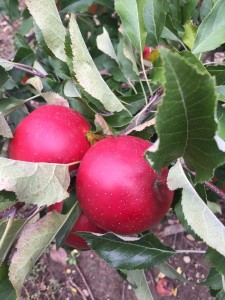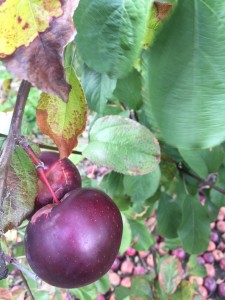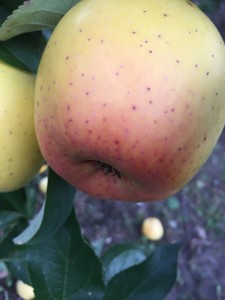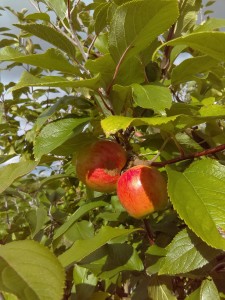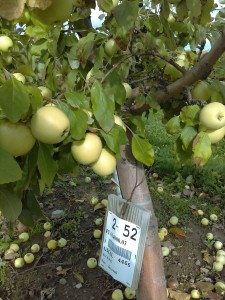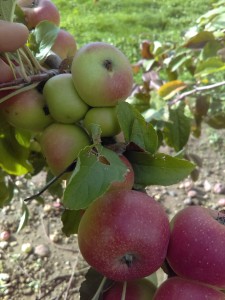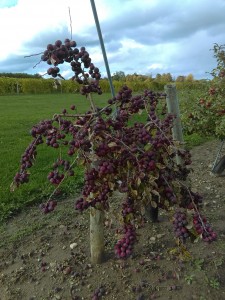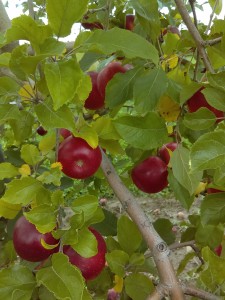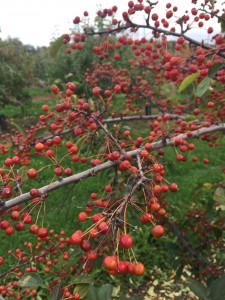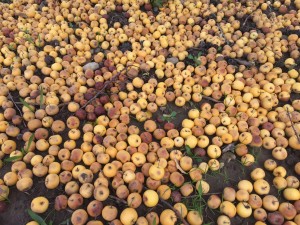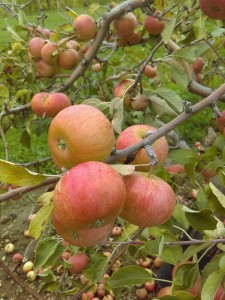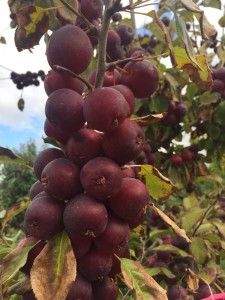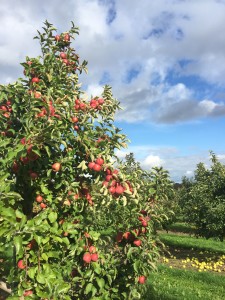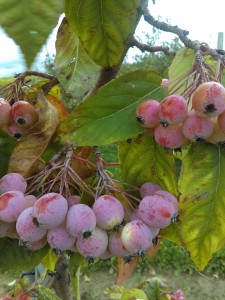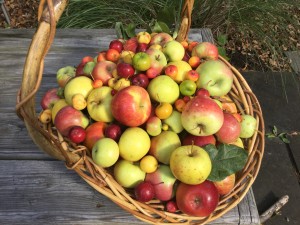
Article and photos by Robyn Mello, POP Program Director. See an extensive photo selection from the tour below the article.
On Monday, I had the sheer joy and privilege of taking the day to visit what is likely the most unique display of Malus (apple) trees in the country, a dream nearly two years in the making. The USDA Agricultural Research Service’s Geneva, NY office is housed within a large office complex alongside the New York State Agricultural Experiment Station and Cornell University Cooperative Extension. Just around the corner from the offices is McCarthy Farm, home of the USDA ARS Outdoor Apple Collection. AKA Apple Heaven.
What is The USDA ARS Apple Collection?
What makes this government apple collection the most unique? It’s a hub for genetic preservation, not a commercial orchard or proprietary plant-breeding farm. It’s focused on keeping alive all the different species within the Malus genus and hundreds of cultivars within the grocery store-ready Malus domestica species. Even the most diverse apple orchards working to preserve heirloom apples or those working to breed new types of apples are most often working with Malus domestica (domesticated apple) alone. Commercial orchards are working with cultivars or varieties. ARS Geneva has 53 species.
A vastly underfunded and understaffed program, ARS Geneva only has a handful of researchers. For example, there’s only one researcher in the whole country dedicated to developing new apple rootstocks! However, C. Thomas Chao, the collection’s Horticulturist and Curator, was kind enough to stand outside in the cold with me for nearly an hour answering my questions.
After that, he allowed me free reign to stay in the orchard and taste any fruit I wanted until the gates were closed! [Envision me, a proverbial kid in a candy store, hiding my glee at this news.] They’re not interested in or able to compete with commercial growers or get involved in Intellectual Property disputes around breeding the newest and best apple cultivar, so there was no secrecy involved. In fact, nearly all of the collection’s material can be requested and received in the form of grafting material from the ARS Apple Collection Catalog for free! They want people to know about and use this material.
Thomas explained there are nearly 8,000 accessions (items) in the collection, about 1,500 of them grown from wild seed around the world and the rest from plant tissue grafted on dwarfing or semi-dwarfing Malus rootstock. 2,000 varieties are present. Thomas said, “We’re the only ones in the country focused on the wild stuff,” probably because “nothing wild will ever be turned into a commercial variety.” The crops are sprayed according to Cornell Cooperative Extension recommendations, but of course, sometimes, trees die. Fortunately, there is a liquid nitrogen cryo-backup system in Fort Collins, Colorado for almost every specimen in the Permanent Collection to ensure things aren’t lost. A friend of mine, Christopher Richards, has a lot to do with the research and maintenance of that collection. He was in the mountains in China doing wild apple research just this past week. I have a really awesome job, but if I didn’t, I’d surely be working to get the proper education to work alongside Chris or Thomas!
Apples most people are familiar with are clones of mother trees found or bred for tasty fruit and grafted onto rootstock with preferable growing qualities (see our earlier blog post about grafting for more explanation). Just as inbreeding with animal species or senescence in gourmet mushroom farming, the reliance on a limited number of monocropped cultivars of apples can ultimately result in weaker specimens, more pest and disease problems, and less tasty and nutrient-rich food. If Malus domestica cultivars begin to fail, rootstocks are attacked by new or stronger pests, or climate change continues to threaten currently-accepted growing conditions, the ARS Geneva genetic databank will allow farmers and scientists to go back to the drawing board.
What are the apples like?
My time in the orchard was cut short due to 11 hours of round trip driving, very cold temperatures, and an afternoon rainstorm, so I was really only able to view the site’s Core Collection (pun hopefully intended) and a row of its wild seed-grown trees. The Core Collection is 3 rows of 258 accessions of apples, including 40 species that represent the maximum genetic diversity of the whole collection. It’s the place researchers start their work, and once they narrow down their search, they may move into a more specific area of species or hybrids within the larger 2,000 accession orchard. As a very amateur researcher, the best I could do is use my eyes and mouth to decide where I want to focus my citizen science research.
Each tree is well-labeled with the species, cultivar name, PI (Plant Identification) number, and GMAL (Geneva Malus) number. PI relates to the number in GRIN Global, the USDA’s national database and Germplasm Resource Information Network (GRIN). GMAL is the local number for The ARS Geneva Catalog, necessary because not all specimens are yet part of the GRIN collection. These numbers are how one can find the specimens they’d like to request from the catalog.
Thomas told me the best time to come is in mid-to-late September, but there were still tons of trees loaded with fruit. Since it’s not a production orchard, no one is harvesting the fruit. Rather, it just falls to the ground when it ripens and is left to rot. Seeing the ground below productive apple trees is really a sight to behold.

The orchard in the sunshine reflected a full palette of colors ranging dark brown, lime green, magenta, canary yellow, cadmium red, burgundy, orange, and baby pink in innumerable combinations and patterns. Their flesh ranged from bright white to pink to yellow to beet red. Some of the fruits were soft with age, others were surprisingly waxy, and others covered in a soft fuzz. They were round, oval, the size of a dime or the size of a grapefruit and everything in between. Flesh textures were crisp, soft, grainy, crunchy, mealy, and starchy. Some were like eating a spoonful of table sugar; some so bitter and astringent that they left a film in my mouth akin to eating an underripe American persimmon; some with such a note of perfume they were hard to eat; some so sour they made my cheeks hurt; but many were just the right combination of sweet-tart complexity.
Bark colors were brown, gray, orange. Leaves were different shapes and sizes–some more like hawthorn than apple–and had vivid orange-red fall colors. The cultivar “Hordapfel” had large green leaves with beautiful purple veins. The fruits even rot differently according to their composition–some just juicing away to nothing, others leaving dessicated fruit mummies.
I tasted probably 100 different apples from at least 24 species. It didn’t take long to realize that their flavor and texture could be pretty regularly categorized according to color and size. My winners of the day were Malus domestica cultivars with orange-hues in their skin and flesh in the yellow spectrum, including names like “Belle de Boskoop”, “Calville Blanc”, and “Orleans Reinette”; as well as smaller fruits with green and pink hues in their skin and white or pink flesh such as “Lady” (a 2,000 year-old cultivar) and “Lady Williams”. The “Liberty” cultivar, which we often plant in our POP partner orchards due to its pest and disease resistance, is definitely one of the tastiest and considered one of the highest in phytonutrients.
Malus sieversii is a species native to Kazakhstan which is believed to be the primary ancestor of most cultivars of orchard apple (Malus domestica), and it is in danger of extinction. Keeping these specimens alive on dwarf and their own rootstocks is very important to this collection and the future of food. Two very late varieties still with fruit on them, KAZ 96 09-02 and KAZ 96 09-02, were pretty tasty, and lots of other large crabapples from various species were deliciously sour as well. If you have a good bit of outdoor space and patience, you can write to C. Thomas Chao requesting a Malus sieversii seed packet from their open-pollinated block, and he’ll send you 25 seeds and instructions for stratification and germination. Beware, however, that they could end up anywhere between 10’ and 50’ tall!
Malus sikkimensis had tiny, transluscent, red-brown fruit. Malus coronaria had waxy green fruit with orange leaves. Malus florentina had clusters of small fruit with hawthorn-like leaves. Malus fusca had some of my favorite crabapple flavor with large clusters of small, oblong, green-brown fruits. Malus bhutanica had gorgeous small magenta fruits, but they were the worst for astringency. Other Malus domestica cultivars I particularly liked were “Smokehouse”, “Snow” (like Snow White?), “Cox’s Orange Pippin”. “M25”, a very common rootstock variety, also had really good fruit. I got to taste very common cultivars like “Delicious”, “Golden Delicious”, “Fuji”, and “Granny Smith” and I was largely unimpressed compared to the lesser-known cultivars. I found that the fruits with dark red/burgundy skin and bright white flesh had some of the most simple, sucrose flavors.
Next year, I’ll prepare to visit for longer and take better notes on cultivars and species for personal and POP nursery purposes. This whirlwind one-day adventure was well worth it!
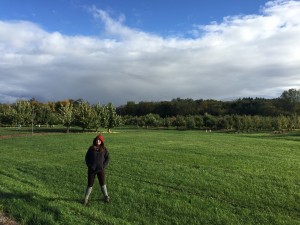
How can you help with this work?
- Request new varieties of apples in your grocery stores. There are many cultivars grown in the United States, but very few of the many thousands known are grown commercially on a large-scale.
- Learn to graft, perhaps at an upcoming POP Grafting Workshop! Then, request plant tissue from the ARS Apple Catalog or GRIN Global Database, grow your own fruit, and feed your neighbors! Orders are due in by January 10, 2017 for next season’s tissue requests.
- Write to your Congressperson and demand that more of our taxpayer dollars be put towards funding crucial non-commercial plant preservation work. The work of the USDA ARS is important to the livelihoods of farm owners and laborers, consumer wallets and diets, our national security, and the survival of several global ecosystems.
- Become a POP Liaison and learn to assist in caring for apple trees (and over 150 other species of edible and medicinal plants) at one of our 50+ community orchards spread throughout Philadelphia!
- Get involved with local seedsavers groups or the Seedsavers’ Exchange out of Chicago to ensure the upkeep of agricultural biodiversity.
- Visit and buy apples from a local heritage apple orchard like Northstar Orchard in Cochranville, PA. You can find a map and listing of other local orchards featuring a wide array of apples (and even search by cultivar) at orangepippin.com.
- Try not to demonize farmers who grow conventionally, but become educated and encourage your local growers to become organic and/or low-spray. It’s extremely challenging–but not impossible–to grow apples organically in our region and climate, due to regularly humid conditions and the fact that almost everyone is reliant on chemicals, making organic and low-spray orchards beacons of hope for pests. Try to find ways to encourage organic growing practices through food policy work, voting with your wallet (buy organic), and volunteering at a local orchard.
- Take a Permaculture Design Course (PDC) to learn how working with the landscape and introducing a greater diversity of species can improve yields and lessen problems. I’m working to develop a Philly-based PDC for 2017, so stay tuned!
I love all creatures, all plants, and all fruit trees. I definitely could not pick a favorite. But there’s something very special about the apple, physically and symbolically. As a genus, it relates to this country’s history, nutritional evolution (or devolution), the development of the agricultural economy, globalization, international development, environmental conservation, technological innovation, climate change, and current political and social trends related to our food system. Our world can easily be viewed through an apple lens. Though many of us probably eat more apples than other fruits, don’t take their abundance in a grocery store for granted. Appreciate your fruit and food-growers, and become a more conscious consumer!
Photos (More Resources Below)
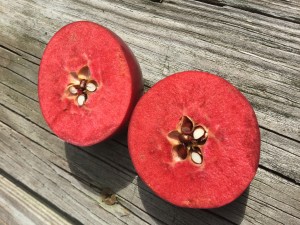
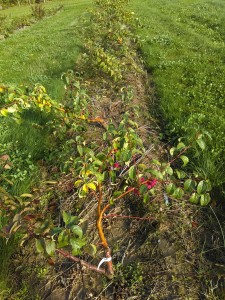
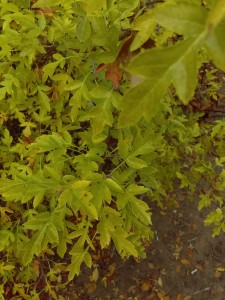
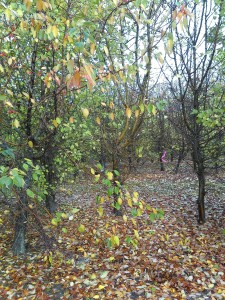
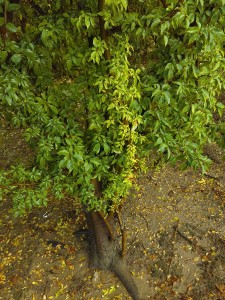
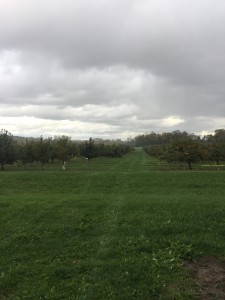
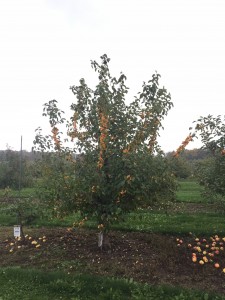
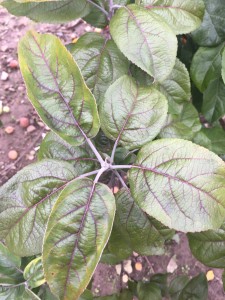
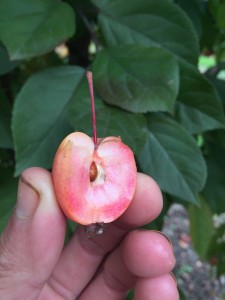
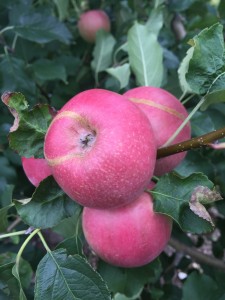
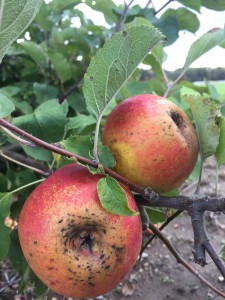
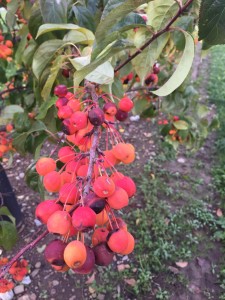
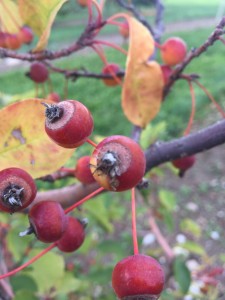
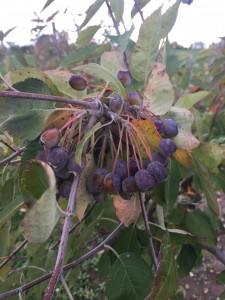
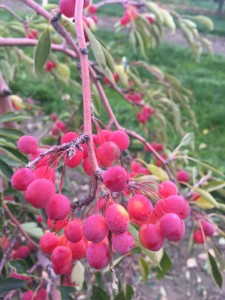
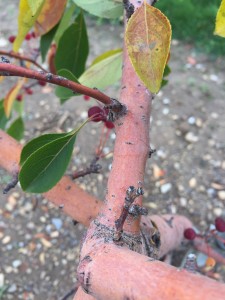
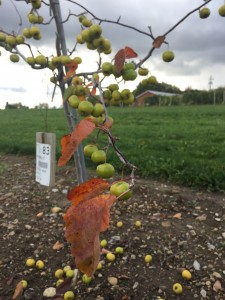
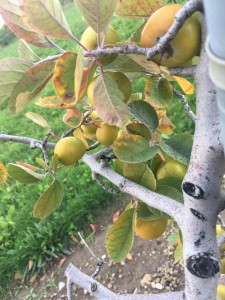
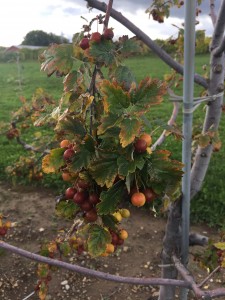
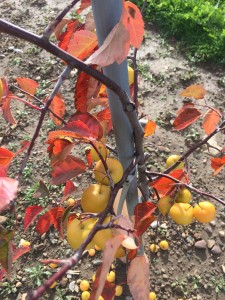
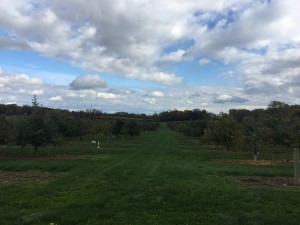
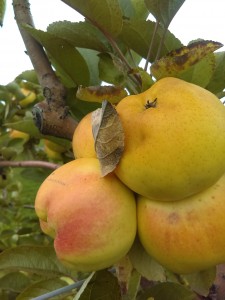
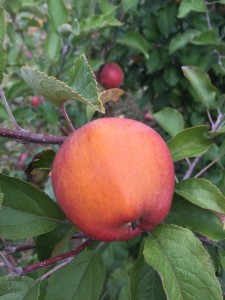
SUPPORT US! If you found this entry useful, informative, or inspiring, please consider a donation of any size to help POP in planting and supporting community orchards in Philadelphia: phillyorchards.org/donate.
MORE RESOURSES
Some Disease Resistant Apple Cultivars
The ReZista Collection
Topaz
Crimson Crisp
Liberty
Enterprise
Pixie Crunch
Honeycrisp
Goldrush
http://extension.missouri.edu/p/G6026
Organic apple production websites
Michael Phillips’ Holistic Orcharding Site – http://www.groworganicapples.com/
Organic Apple books – http://www.groworganicapples.com/organic-orchard-books/
http://extension.psu.edu/plants/sustainable/news/2009/10/6organicapple
http://www.agmrc.org/media/cms/omapple_5E5179AB39A2F.pdf
http://ucanr.edu/sites/placernevadasmallfarms/files/112366.pdf
http://www.fruit.cornell.edu/tree_fruit/GPGeneral.html
Sources of Knowledge and Heritage/Resistant Apple Varieties
Lee Calhoun – Southern Heritage Apple Collection
John Bunker – Super Chilly Farm and FedCo Trees, Maine
North Star Orchard – PA
Orange Pippin – England Database, maybe available in USDA Collection
Susan Brown, Apple Breeding Program, Cornell – https://hort.cals.cornell.edu/people/susan-brown
Seedsavers Exchange – http://www.seedsavers.org/
University of Minnesota Apple Varieties – http://mnhardy.umn.edu/varieties/fruit/apples
Washington State University Apple Breeding – http://dialogue.tfrec.wsu.edu/breed/
USDA And Global Fruit Research Resources
ARS Geneva website – https://www.ars.usda.gov/northeast-area/geneva-ny/plant-genetic-resources-research/
Google Scholar (for USDA Research articles) – https://scholar.google.com/
USDA Plant Collection Database – GRIN Global – http://www.grin-global.org/
ARS Geneva Apple Collection Catalog – https://www.ars.usda.gov/ARSUserFiles/80600500/ClonalCatalogs/2016/MCatalog16.pdf
(Best to search by PI number)
Apple Rootstock Breeding Program – https://www.ars.usda.gov/northeast-area/geneva-ny/plant-genetic-resources-research/docs/national-apple-rootstock-breeding-program/
Global Fruit News from Yentzen Group – http://www.freshfruitportal.com/
Good Fruit Grower Magazine – http://www.goodfruit.com/
